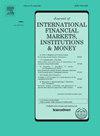Predicting the conditional distribution of US stock market systemic Stress: The role of climate risks
IF 6.1
2区 经济学
Q1 BUSINESS, FINANCE
Journal of International Financial Markets Institutions & Money
Pub Date : 2025-03-21
DOI:10.1016/j.intfin.2025.102156
引用次数: 0
Abstract
This paper explores how climate risks impact the overall systemic stress levels in the United States (US). We initially apply the TrAffic Light System for Systemic Stress (TALIS3) approach that classifies the stock markets across all 50 states based on their stress levels, to create an aggregate stress measure called ATALIS3. Then, we utilize a nonparametric causality-in-quantiles approach to thoroughly assess the predictive power of climate risks across the entire conditional distribution of ATALIS3, accounting for any data nonlinearity and structural changes. Our analysis covers daily data from July 1996 to March 2023, reveals that various climate risk indicators can predict the entire conditional distribution of ATALIS3, particularly around its median. The full-sample result also carries over time, when the nonparametric causality-in-quantiles test is conducted based on a rolling-window. Our findings showing that climate risks are positively associated with ATALIS3 over its entire conditional distribution, provide crucial insights for investors and policymakers regarding the economic impact of environmental changes, especially since we confirm that the results continue to be robust in an international-setting involving 11 important stock markets of the European Union.
预测美国股市系统性压力的条件分布:气候风险的作用
本文探讨了气候风险如何影响美国(US)的整体系统压力水平。我们最初应用系统压力交通灯系统(TALIS3)方法,根据压力水平对所有50个州的股票市场进行分类,以创建一个称为ATALIS3的总压力测量。然后,我们利用一种非参数的分位数因果关系方法来全面评估气候风险在整个ATALIS3条件分布中的预测能力,考虑到任何数据非线性和结构变化。我们的分析涵盖了1996年7月至2023年3月的每日数据,表明各种气候风险指标可以预测ATALIS3的整个条件分布,特别是在其中位数附近。当基于滚动窗口进行非参数分位数因果关系检验时,全样本结果也会随着时间的推移而持续。我们的研究结果表明,气候风险与ATALIS3的整个条件分布呈正相关,这为投资者和政策制定者提供了关于环境变化的经济影响的重要见解,特别是因为我们确认了在涉及欧盟11个重要股票市场的国际环境中,结果仍然是稳健的。
本文章由计算机程序翻译,如有差异,请以英文原文为准。
求助全文
约1分钟内获得全文
求助全文
来源期刊
CiteScore
6.60
自引率
10.00%
发文量
142
期刊介绍:
International trade, financing and investments, and the related cash and credit transactions, have grown at an extremely rapid pace in recent years. The international monetary system has continued to evolve to accommodate the need for foreign-currency denominated transactions and in the process has provided opportunities for its ongoing observation and study. The purpose of the Journal of International Financial Markets, Institutions & Money is to publish rigorous, original articles dealing with the international aspects of financial markets, institutions and money. Theoretical/conceptual and empirical papers providing meaningful insights into the subject areas will be considered. The following topic areas, although not exhaustive, are representative of the coverage in this Journal. • International financial markets • International securities markets • Foreign exchange markets • Eurocurrency markets • International syndications • Term structures of Eurocurrency rates • Determination of exchange rates • Information, speculation and parity • Forward rates and swaps • International payment mechanisms • International commercial banking; • International investment banking • Central bank intervention • International monetary systems • Balance of payments.

 求助内容:
求助内容: 应助结果提醒方式:
应助结果提醒方式:


